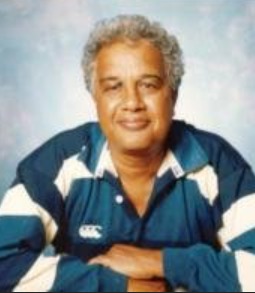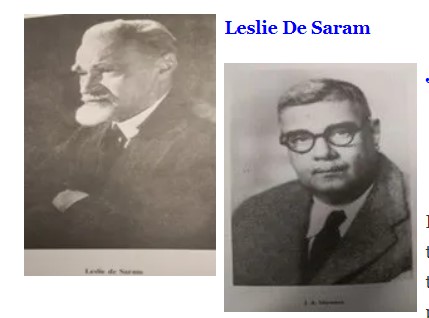Leslie de Saram and Aubrey Martensz: Straddling Ceylon & the British Empir-by Michael Roberts

Source:Thuppahis
Hugh Karunanayake, in The Ceylankan, Journal of the Ceylon Society of Australia, No 100, vol 25/4, November 2022, where the title reads “Two Acclaimed Lawyers who migrated from Ceylon During the Days of the ‘White Australia’ Immigration Policies” … with the highlighting here being an imposition by The Editor, Thuppahi
The names Leslie de Saram and Aubrey Martensz are not likely to evoke sentiment of any kind from contemporary Sri Lankans. They were two outstanding lawyers who not only dominated legal practice and legal education, but also were very influential members of the profession and of Colombo’s social scene. Both de Saram and Martensz were at various times partners of the well-known legal firm FJ and G De Saram, founded by Leslie de Saram’s grandfather, FJ de Saram Senior, in 1841.
FJ De Saram (Snr) was the grandson of Maha Mudaliyar Christtofel de Saram the son of Johan Henriques de Saram who was only 14 years old when taken to England by Governor Maitland, handpicked from among the leading “native” families as suitable for higher studies. That headstart created a dynasty of lawyers.

It is widely acknowledged that the transformation of the island’s economy from a peasant based subsistent economy to a surplus making plantation economy after the British conquest of Ceylon, was characterized by a massive transfer of ownership of both crown land and private holdings. Lands were sold to entrepreneurs from Britain who initially planted coffee, and later tea and rubber. The legal conveyancing which was necessary to establish ownership was dominated by three legal practices viz that of FJ de Saram, VA Julius and FC Loos. All three virtually monopolised the conveyancing associated with the sale of crown land, as well as commercial properties associated with the plantation sector in Colombo.
FJ de Saram later formed a partnership with his relative George de Saram to form the well-known firm of FJ and G de Saram. FC Loos, whose son Hermann is best remembered for the Hermann Loos trophy, awarded to the best cadet contingent among competing schools did not perpetuate his legal practice through succeeding generations. VA Julius in association with his partner Harry Creasy formed the redoubtable firm of lawyers Julius and Creasy, which virtually monopolised the legal work of British companies in Ceylon during the twentieth century. The partnership created by FJ de Saram (senior) is now in its 181st year of existence and still in command of extensive legal work from the country’s large mercantile sector.
It may be appropriate if we discuss the lives of Leslie de Saram and Aubrey Martensz in relation to their family and its position in Sri Lankan society in order give better perspective to their roles in public life. A fact that is hardly remembered today is that the family was dominant in national life from the beginning of the 19th Century when the British took over the administration of the country, continuing well into the twenty first century.
The De Saram and Martensz families began their association when FJ de Saram (Snr) commenced work under Proctor Andries Martensz on 13 May 1841. Proctor Martensz was the administrator of de Saram’s grandfather Maha Mudaliyar Christtofel de Saram’s Estate. De Saram, just 19 years of age at the time, applied for enrolment as a Proctor two years later. The association between the two families became closer when De Saram sought the hand of Martensz’s daughter Ann in marriage. The couple married on 12 October 1843, the groom just over 21 years old and the bride over 16 years of age. While the De Sarams considered themselves Sinhalese in ethnicity, Ann Martensz’s mother and maternal grandparents were Dutch. The link between the two families bonded by marriage was to last over 140 years.
FJ de Saram’s (Senior) marriage to Ann produced 12 sons and daughters. He died at 49 years of age. His son FJ de Saram (jnr) was only 22 years of age at the time.
The partnership continued with FJ de Saram (Jnr) and his brothers until the entry of Leslie de Saram, the eldest son of FJ de Saram Jnr who had two other sons Stanley and Eustace. Eustace died in 1919. Stanley joined the firm and was a partner until he was invited by Leechman and Co to be a Partner on its Board and was its first Ceylonese Chairman. He was appointed Chairman over the heads of many Senior British executives who were assured by the departing Chairman that Stanley De Saram’s position would enhance both the reputation and the business outreach of the firm.
Leslie continued to be the senior partner of FJ and G de Sarams, a position he reached in 1918. It has been said that Leslie’s father FJ de Saram (Jnr) trebled the volume of business to which he succeeded and it could be safely concluded that under Leslie’s leadership, the business would have even expanded more.
Like his grandfather, Leslie married a Martensz: Theodora Martensz who was a first cousin, thus continuing the close links between the De Saram and Martensz families. Three of Theodora’s brothers became partners of the firm. Two of them Aubrey and David became Senior partners.
Leslie was known to be an avid collector of antiquities of which he had amassed a large and unique collection and was on display at his home “Brentham” in Cambridge Place. Some of the more notable unique items in his collection included a grandfather clock once owned by a Dutch Governor. He also had guns, swords and other implements of warfare used by the last King of Kandy Sri Wickrema Rajasinghe. The clock and his collection of rare books were donated to the newly established Peradeniya University, the Vice Chancellor of which Sir Ivor Jennings had been a close friend. The clock, however, came to a sorry end during a student uprising: the students apparently unaware of the historical significance of the antique clock, or perhaps not bothered about its significance even if they were aware.
Another notable donation was his donation of his 35-acre farm at Gurutalawa to St Thomas College. Although Leslie, his, father, grandfather, and great grandfather had all received their education at Royal College ( the school of their fathers who learnt their way before them!) they were all very supportive of the Anglican Church, hence the donation to S Thomas College of which he was a member of the Board of Governors.
Yet another notable donation was the gift of two personal contributions of 5000 British pounds each, to the war effort during World War 2. The gift was made with the request that the source be not revealed, but the Governor Sir Andrew Caldecott made a personal request that the gift be given publicity as it would encourage others to follow suit.
Philanthropy was nothing new to the de Sarams as FJ de Saram Jnr, Leslie’s father, had donated the cost of an aircraft to the British war effort in World War One. Leslie’s brother Stanley like Leslie, also resided in a large mansion in Cambridge Place called “The Eyds.” He and his wife Aimee were gracious hosts to Lady Clementine Churchill the wife of Sir Winston Churchill who spent a fortnight’s holiday with the de Sarams in January 1956. Clementine was recuperating from an illness and desired to spend some time in Ceylon.
The British High Commission in Colombo felt that it would have been good if the visitors were hosted in a private home rather than in an impersonal hotel. They were aware that Stanley de Saram and his wife lived in a splendidly fitted home and were served by a dozen domestic staff including a butler, chef and others. At the time social life at the upper end in Colombo was dominated by British expatriates who dominated the Mercantile sector of Ceylon. However, the High Commissioner felt that Stanley de Saram was the best suited and equipped to play hosts to the VIPs and approached the de Sarams who readily agreed. That visit by Lady Clementine Churchill and her cousin and closest friend Sylvia Henley was reciprocated by an invitation to spend a holiday with the Churchills in their home Chartwell in Kent where the de Sarams enjoyed a memorable holiday a few months later. Both Leslie and Stanley had no children. Leslie however adopted the two children of a sister of his.
A man described as “to the manor born” Leslie chose to spend his retirement in England, but later decided on Australia as he could not withstand the cold winters of England. His home in Cambridge Place, opposite the Colombo Museum, was purchased by the Australian Government and served as its Embassy for several decades. Leslie de Saram settled down in Canberra but also had a home in Sevenoaks, Kent, in England where he passed away at the age of 84 in in 1961. A great Ceylonese who had played a significant role in the development of the country passed away as quietly as he lived.
J Aubrey Martensz, born on 5 September 1885 and educated at Royal College, was a Senior Partner of the firm of FJ and G de Saram in 1947 and 1948. He was a close friend of the Prime Minister DS Senanayake who appointed him as Ceylon’s first High Commissioner to Australia in July 1948. In April 1947 the First Australian High Commissioner in Ceylon Mr CW Frost cabled to Canberra on the impending appointment of Mr Aubrey Martensz. His cable stated: “Mr Martensz aged 63 is a nominated member of the House of Representatives. He is a Burgher and a prominent Solicitor until he discontinued practice on appointment to Parliament. Of high social standing he is well liked by all communities and all members of Government.” After completing his tenure as High Commissioner, he returned to Ceylon where he was appointed Chairman of the Associated Newspapers of Ceylon Ltd. Mr Martennz was a bachelor and he later migrated to Australia where he lived in Canberra in retirement. He died in March 1963 aged 78 years. In the biographical note which was maintained by the Australian Government regarding Mr Martesnz’s ethnic makeup was described as 62 ½ % Dutch, 25% Scottish, and 12 ½ % Sinhalese.
On looking back at the family structures of the De Sarams and the Martenszs the many intermarriages between the two families suggest that they were from one composite family rather than of two branches. Both Leslie de Saram and Aubrey Martensz were legal professionals who shone in their sphere of work and were elite members of an urban society dominated by European manners and customs. Their philanthropy, the concern for the less fortunate, and the leadership given to setting the pace for high public standards, integrity in public life, and dedication to the country, are some values sadly lacking in Sri Lanka of recent times. Their lives however could be hailed as of such quality and standard as could be emulated by contemporary and future Sri Lankans.
Acknowledgement: “160-year practice of a Law firm in its historical setting” published by FJ and G de Saram, Colombo 2001.







